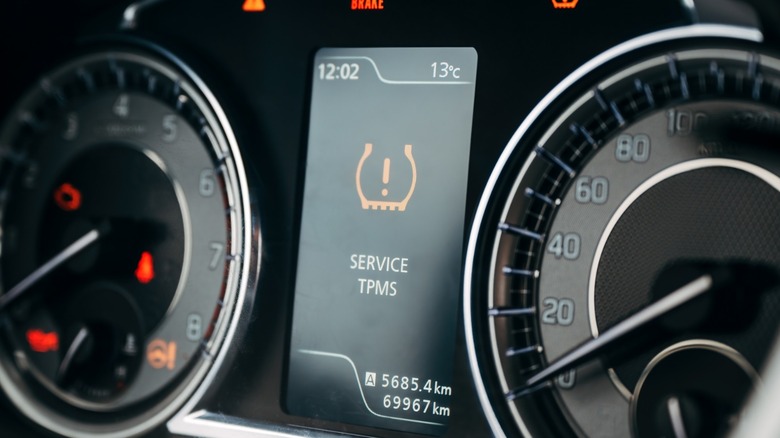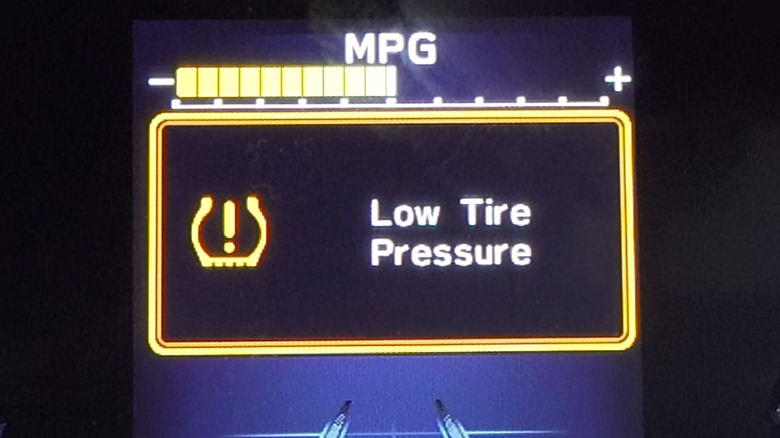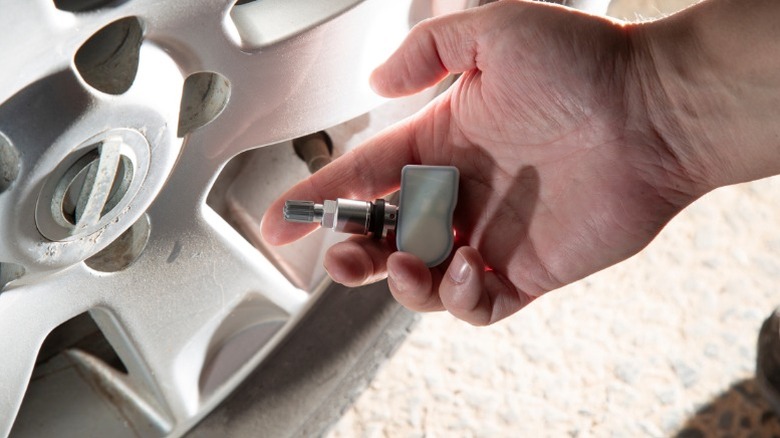What TPMS Stands For (And Why The Light Keeps Coming On In Your Car)
Modern vehicles are more capable than ever. They can alert us to engine or mechanical malfunctions, thanks to the onboard diagnostic (OBD) system, and numerous advanced safety systems, like blind spot warning, lane keep assist, and 360-degree cameras, help keep us and our passengers secure on the road. One particularly valuable feature that you can find on most contemporary cars is the TPMS, or tire pressure monitoring system. These systems are designed to monitor the air pressure in your car's tires and notify you when one or more of the tires is low on air.
Tire pressure monitoring systems work either by using the data collected by the anti-lock brake system (ABS) speed sensors to track the wheel's rotation, or by using sensors installed on the wheels themselves to monitor tire pressure and air temperature. If the data that the system collects indicates that one or more tires are filled incorrectly, it can trigger one of your car's many dashboard warning lights. The TPMS light looks like an exclamation point inside a transparent tire or inside two parentheses. Usually, you can turn this light off by filling the tires to the correct level. However, in some cases, you may need professional assistance or a special procedure to deactivate the light.
Why your car's TPMS light keeps appearing
If your car's TPMS light keeps turning on, it generally indicates one of a few different issues. If the light turns on and stays on, it usually means there's a problem with tire pressure. Even if you fill your tires regularly, a small leak could be present, causing the TPMS light to reappear every so often. You should check your tires regularly to avoid issues like this, and you should inspect them anytime the TPMS light appears to rule out more serious problems.
If all of your tires (including your spare) are in solid condition and your TPMS light turns on and blinks, you may have one or more faulty TPMS sensors or wheel speed sensors. If your car has an indirect TPMS, meaning it relies on the ABS speed sensors to monitor tire pressure, then you may notice that the ABS light turns on in conjunction with the TPMS light. Regardless of the type of TPMS your vehicle uses, a bad sensor can be to blame for the light's appearance. The tricky thing is diagnosing a faulty sensor, as it usually involves using a scan tool to communicate with the car's computer system and identify which sensor is bad. Tools capable of diagnosing faulty TPMS sensors can be pricey, and most people will have to visit a shop for the diagnosis.
While faulty sensors are among the most common causes of a blinking TPMS light, the issue can appear due to other problems, too. Electrical issues within the TPMS, like a frayed or broken wire or a malfunctioning module. Automotive electrical problems can be tough to diagnose, though, and you'll likely need a professional mechanic's help if you suspect this issue.
How to fix a TPMS light that keeps appearing
The simplest reason for the TPMS light's appearance is low tire air pressure. If one of your tires has a small leak, it's very likely that your light will continue to appear, in spite of your efforts to keep the tires inflated properly. Fortunately, checking for a small leak is relatively simple. To do so, spray a mixture of soap and water onto your tires and look for air bubbles that indicate a leak. If you do discover a leak, the best way to address the problem is by patching or plugging the hole or replacing the tire.
If your TPMS light is blinking, it usually means there's an issue within the system. If you're able to identify a faulty sensor as the source of the problem, the fix can be relatively simple or complex, depending on the type of TPMS. Indirect tire pressure monitoring systems use the ABS wheel speed sensors. These sensors are typically located on the wheel hubs, and replacing them is usually as simple as disconnecting an electrical plug and removing a few bolts. On the other hand, replacing a direct TPMS sensor is substantially more involved and almost always requires you to remove the tire from the wheel. These types of replacements also frequently require access to an expensive TPMS tool to reprogram the system and turn off the light, which is why you probably shouldn't attempt a DIY TPMS sensor replacement.
Finally, if your TPMS light is on and blinking because of an electrical or TPMS module malfunction, you will have to replace the damaged parts. This can be complex and expensive, depending on the vehicle and your automotive experience, and electrical repairs are usually best left to professionals.


